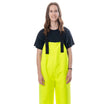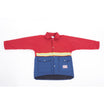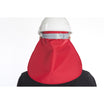For construction workers, braving the elements is part of the job. Whether it's relentless summer heat or inclement winter rain, their resilient spirit paired with the right gear keeps the work going. Among the many tools and equipment in a construction worker's arsenal, rain gear holds a significant place. It's not just about keeping them dry; it's a matter of safety, productivity, and comfort. But as durable as they may be, rain gears are not indestructible. They need proper care to ensure they serve their purpose for the longest possible time. With the right knowledge and practices, you can extend the lifespan of your rain gear, leading to efficiency, sustainability, and cost-saving. But how exactly do you achieve that? This article will share some insights on this topic, shedding light on the value of rain gear for construction workers, how to choose it rightly, ways to give it the care it needs, and how to handle damages efficiently. So let's dive in and make the most out of your protective gear!
Importance of Rain Gear for Construction Workers
When you think of construction sites, the first things that often come to mind are the heavy machinery, noise, dust, and those iconic hard hats. But what might slip your mind is the all-essential rain gear that construction workers need. The importance of appropriate rain gear for construction workers cannot be overstated. Ensuring safety and boosting productivity, it plays a crucial role in the day-to-day operations of a construction site when the weather decides not to cooperate. Thus, let's delve deeper into these two key factors that proficiently highlight the vitality of rain gear in the construction industry.
Safety
The safety benefits of rain gear for construction workers are ample. For starters, it safeguards workers from slips, falls, and other accidents on the job during inclement weather. When it pours, surfaces can become slick and hazardous. In such scenarios, a construction worker's rain gear provides that much-needed protection by offering extra traction and stability.
- It helps maintain the body's heat, preventing cold stress and other severe weather-related illnesses.
- It shields against potential skin irritations that may be caused by wet clothes rubbing against the skin throughout the working hours.
- High-visibility rain gear can increase a worker's visibility during inclement weather, reducing the likelihood of accidents involving machinery or vehicles.
The proper rain gear is an essential addition to a construction worker's safety toolbox, as it increases a worker's security and wellbeing during adverse weather conditions.
Productivity
Beyond safety, an adequate rain gear significantly contributes to a construction worker's productivity. As the saying goes, "time is money," and in the construction industry, this rings especially true. Weather conditions like heavy downpours can lead to unnecessary delays if workers aren't adequately equipped to handle such conditions. However, with the right rain gear:
- Workers can continue their jobs, ensuring that deadlines are met and projects are not delayed.
- They can stay warm and dry, leading to less discomfort, which in turn can boost focus, morale, and efficiency.
- It reduces the need for frequent breaks to change into dry clothes, leading to more consistent workflow.
Assets like rain jackets, pants, boots, and gloves enable construction workers to work seamlessly, even amidst unpredictable weather conditions, thereby ensuring that productivity doesn't take a dip.
Distilled to its essence, the importance of rain gear for construction workers is profound. Its pivotal role in ensuring safety and enhancing productivity serves as a testament to its value in the construction industry. As unpredictable as weather can be, having reliable rain gear stands as a bolster against the elements, ensuring that construction work remains as flawless and efficient as possible.
Choosing the Right Rain Gear
Selecting the most appropriate rain gear can be quite challenging, given the vast array of products available in the market. As with other apparel, there is no such thing as one-size-fits-all when it comes to rain gear. It's crucial to find something that fits your specific needs while offering the best protection against the elements. You need to consider the material, fit, and visibility of the gear before making a purchase.
Materials
Different types of materials define the protective nature of rain gear. They determine how well the apparel guards against rainfall, how long it lasts, and how comfortable it is to wear.
- Waterproof Materials: Some rain gear is made of waterproof materials that offer unparalleled protection against heavy rain. These materials offer high resistance to water, making them suitable for heavy rainfall situations.
- Water-Resistant Materials: These materials are best for light drizzles as they provide a basic level of water resistance. They might not hold up well against heavy rain but are breathable and comfortable to wear.
So, when selecting rain gear, remember different materials offer different levels of water resistance and longevity.
Fit
Another important aspect to consider is how the rain gear fits. It should be large enough to be worn over your regular clothing but compact enough not to limit your freedom of movement. Consider the following points when gauging the fit:
- Size: The gear should fit well over your regular clothing. A size too small might restrict movement while a size too large may allow rain to seep in.
- Fastenings: The gear should have secure fastenings, such as zippers or buttons, to ensure it stays put and provides maximum protection against rain.
- Seams: Check for sealed or taped seams that prevent water leakage and increase the longevity of the gear.
Visibility
Visibility can be key, especially in hazardous workplace environments or when outdoors in extreme weather. Rain gear with reflective surfaces can enhance visibility during heavy rain, making the wearer more noticeable to others. A few factors to consider are:
- Reflective patches: Opting for gear with reflective patches can significantly increase visibility.
- Bright colors: Bright-colored gear can also enhance visibility.
- Headgear visibility: If the gear includes a helm or hood, make sure it doesn’t obstruct your field of vision.
With the right rain gear, bad weather will no longer be an obstacle. Consider all these factors while making your purchase, and you'll surely find something that fits your specific needs perfectly.
Essential Care Tips to Extend the Lifespan of Rain Gear
As you dodge puddles and brave wild weather, your rain gear acts as the unsung hero, shielding you from the elements. Merely owning high-quality rain gear isn't enough; you must also take proper care of it to maximize its efficiency and extend its lifespan. Here are a few essential tips on cleaning, storage, and regular inspection to keep your rain gear in top-notch condition.
Cleaning
When it comes to cleaning your rain gear, it's crucial to use gentle, non-destructive products. Avoid strong solvents or acidic cleaners as they can degrade the material and compromise its water-resistant properties. Using a mild soap or a specialized gear cleaner along with lukewarm water will ensure your rain gear stays clean and functional. The process should ideally be as gentle as possible to avoid causing unnecessary wear and tear. After washing, always rinse thoroughly since soap residues can attract dirt and grime.
Storage
Proper storage is another integral part of maintaining the longevity of rain gear. The rule of thumb is to keep your gear in a cool, dry place away from direct sunlight, which can break down materials over time and weaken its overall structure. Also, avoid packing rain gear while still damp as it promotes the growth of mold, mildew, and unpleasant odors.
Regular Inspection
Last but not least, frequent inspection of your rain gear is vital to spot any potential damages early. Look for signs of material breakdown, such as flaking or peeling, as these are often indications of water-resistant coating deterioration. If the waterproof performance of your gear is compromised, consider applying a waterproofing treatment to restore its functionality.
Remember, properly cared-for rain gear not only lasts longer but also provides superior protection against the unpredictable weather. Apply these essential care tips and make each wear count!
Repairing Damaged Rain Gear
Just like your favorite adventure buddy, your rain gear accompanies you through every trail, storm, and chill, and inevitably may suffer some wear and tear over time. Rather than replace it the moment a rip or tear appears, consider repairing it. In this step-wise guide, you'll discover the top three ways to repair your damaged rain gear - from user-friendly patch kits to the effective fabric glue method and knowing when to seek professional help.
Patch Kits
When nature's obstacles leave marks on your rain gear in the form of minor tears or punctures, you don't need to worry, waterproof patch kits have got you covered. These kits offer a swift and user-friendly solution for small tears and holes. They usually consist of a waterproof adhesive patch and a sealing compound that bonds powerfully with different types of fabric to provide an efficient and lasting repair. Here are a few reasons to have a patch kit handy:
- They offer quick and easy application.
- They strengthen the gear without compromising on flexibility.
- They are suitable for a vast range of fabrics.
Fabric Glue
Another practical method for repairing rain gear involves using fabric glue. This convenient tool does not just stick bits and pieces together but reinforces and salts seams. However, fabric glue should be used thoughtfully so that it doesn't strengthen the gear at the expense of flexibility. Here are some useful tips:
- Make sure the fabric is completely clean and dry before application.
- Apply sparingly - a little goes a long way.
- Allow the glue to dry fully for a solid and durable repair.
Professional Repairs
Even the most independent outdoor enthusiast may occasionally encounter damage that's beyond a simple do-it-yourself fix. When dealing with extensive damage where either numerous repairs are required, or the repair is too complex, it could be time to seek professional repair services. Here are the advantages of professional repair:
- Experts have the necessary experience and tools to perform complex repairs.
- They can ensure the repair is waterproof and long-lasting.
- Seeking a professional means less time spent repairing and more time adventuring!
Remember, with a bit of care and attention, even a torn favorite can continue to serve you well. By knowing when to patch, glue, or call in the pros, you can extend the life of your rain gear and continue enjoying your outdoor adventures!
Final Thoughts
Choosing and caring for your rain gear can make a significant difference in your comfort, productivity, and safety when working in rainy weather conditions. From selecting the right kind of materials, ensuring a proper fit for flexibility and coverage, and going for highly visible gear for safety, it's crucial to ensure you're outfitted correctly for unpredictable weather.
The maintenance routine and reparative steps like cleaning, appropriate storage, regular inspection, patching holes or tears are equally imperative to extending the lifespan of your rain gear. But if any of these seem daunting tasks, professional repairs could be an excellent method to protect your investment and ensure your safety gear is in top condition.
While it's important to take care of the rain gear you already own, don't be shy about upgrading when the time comes. We at Hurricane Raingear are always available to serve you with our premium range of waterproof and rip-resistant rain gear, handcrafted for durability, comfort, and unmatchable protection.
We believe that science, care, and craftsmanship play an integral role in making the best rain gear. We guarantee this essence is intact in our products, which you're sure to love and trust while facing the stormy days at a construction site or in daily life. When you choose Hurricane, you're not just choosing a product - you're embracing a way of life that prioritizes safety, comfort, and the willingness to face any climate head-on.
Frequently Asked Questions
-
What are some essential tips to make your rain gear last longer?
To make your rain gear last longer, here are some essential tips: 1. Clean and dry your rain gear after each use. 2. Avoid excessive stretching or pulling. 3. Store your rain gear in a cool and dry place. 4. Avoid exposure to direct sunlight for extended periods. 5. Follow the manufacturer's instructions for washing and maintenance.
-
How often should I clean my rain gear?
It is recommended to clean your rain gear after each use to remove dirt, debris, and sweat. Regular cleaning helps maintain the integrity and performance of the gear, ensuring it lasts longer.
-
Can I machine wash my rain gear?
Most rain gear can be machine washed, but it is important to check the manufacturer's instructions first. Use a gentle cycle with mild detergent and avoid fabric softeners, bleach, and hot water. After washing, hang dry your rain gear.
-
Should I waterproof my rain gear?
Most rain gear comes pre-treated with a waterproof coating. However, over time, this coating may wear off. To maintain the waterproof capabilities, you can use a waterproofing spray or wash-in waterproofing solution as recommended by the manufacturer.
-
What should I do if my rain gear gets damaged?
If your rain gear gets damaged, it is best to repair it as soon as possible. Many rain gear manufacturers offer repair services or provide instructions on how to patch small holes or tears. If the damage is extensive, it may be best to replace the damaged gear.





















Leave a comment
This site is protected by hCaptcha and the hCaptcha Privacy Policy and Terms of Service apply.